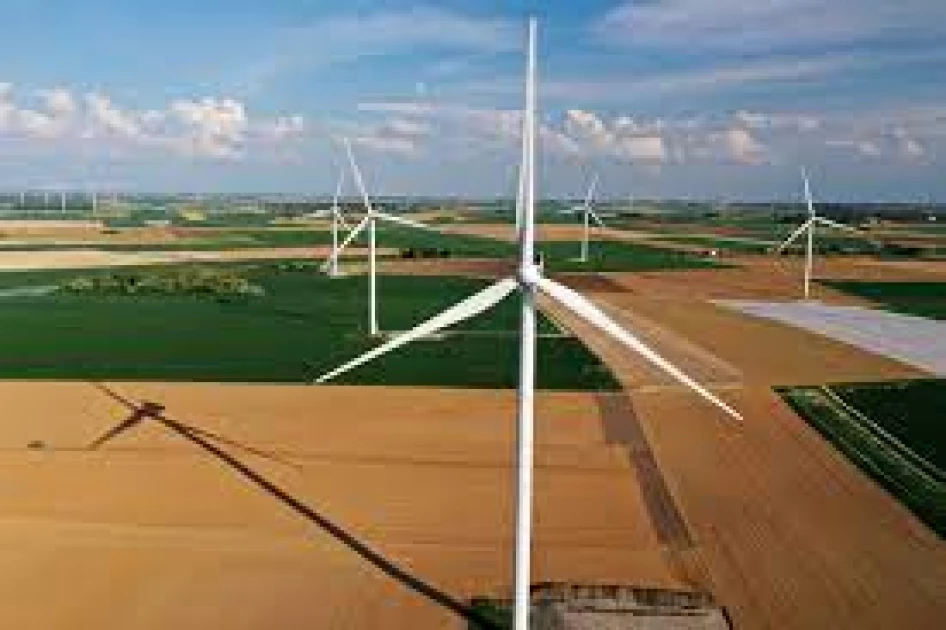OPINION: Flexible renewable technology, not gas, is Africas energy solution

An aerial view shows power-generating windmill turbines in a wind farm in Graincourt-les-Havrincourt, France, April 27, 2020. Picture taken with a drone REUTERS/Pascal Rossignol/File Photo
Africa’s rich endowments of solar, wind, hydropower and geothermal among other green energy resources give the continent a head-start. Increased investments and development would take it to the finish line.
The continent’s potential wind resource, for instance, exceeds 59,000GW, according to a study by International Finance Corporation (IFC), which is enough to power the continent’s energy demand 250 times over. Yet, more than half the population lack access to electricity and clean cooking solutions.
Natural gas is being pushed as the solution for Africa’s energy needs as world leaders meet in Cairo for the COP27 climate summit. It’s important that each country runs a cost-benefit analysis in deciding whether to adopt gas or not.
For most countries, gas wouldn’t make economic sense.
Nigeria, for instance, knows that it would take decentralised solutions such as solar-powered mini-grids if it’s to achieve universal power access, especially in the northern parts of the country largely cut off from the national grid.
Lighting up these rural states using gas-fired electricity would require large investments in grid expansion, an exercise that can take decades. Nigeria should instead make better use of the gas that has historically been flared from its oilfields.
With development highly concentrated in major towns and cities, much of sub-Saharan Africa would find extending national grids to all remote villages too expensive, a process that could take another century if not longer.
This means that without the off-grid power interventions, most communities would still remain in the dark even with gas-fired power addition to the central grid.
The good news is that decentralised solar solutions continue to record cost decreases and can be deployed and installed quickly to ensure energy access for all.
Average global costs of solar PV and onshore wind have more than halved in the past decade. Over the same period, fossil fuel prices including gas have fluctuated wildly, most recently roughly doubling due to the war in Ukraine.
Because gas is a globally traded commodity, its price everywhere is driven at least partly by global supply and demand regardless of whether a particular country has domestic gas resources or not.
Moreover, unlike renewable power, whose cost can be largely fixed at the point of deployment, gas power costs often fluctuate to reflect movements in fuel prices.
For a majority of African governments, embracing fossil fuels as the basis for development essentially locks them into dependence on globally traded commodities.
Africa produces only about 8.1 per cent of global oil today, and Nigeria which has the largest proven reserves in Africa only accounts for 2.2 per cent of global total reserves and ranks 14th in production.
Most African countries (almost 40) have no proven oil and gas reserves, and could therefore lead the continent in the renewable energy drive.
Energy supply is not the only challenge in most parts of Africa. High tariffs, due to global price volatility of fuels, pose an equally big challenge. Underdeveloped networks also mean large parts are cut off from the national grid.
The volatility of fossil fuel costs also directly impacts energy security and economic stability since fossil fuel imports are, for most African countries, the single largest import item, meaning that shifts in fuel price immediately show up in all prices as inflation.
Conversely, once installed, renewables are a localised asset whose energy production costs only vary modestly with costs of maintenance.
With abundant renewable energy sources, Africa can lead the sustainable energy transition curve to become energy secure.
To achieve this, African leaders need to negotiate more with developed countries and investors to unlock investment flows to Africa. There’s actually enough money for renewables only that it’s not flowing to Africa.
Out of the $2.8 trillion that went into renewable energy between 2010 and 2020, only two per cent came to Africa, according to the International Renewable Energy Agency (IRENA).
It is worth noting that renewable energy investments in Africa actually have a stronger business case than almost anywhere else in the world.
According to World Bank’s Global Solar Atlas, a commercial solar installation in Kenya or Nigeria generates 60 per cent more energy than a similar-sized plant in central Europe. This means that investing in African solar can hand investors more returns.
The 310MW Lake Turkana Wind Power in northern Kenya boasts an average capacity factor of 58 per cent and 50 per cent for the 100MW Kipeto wind farm – much higher compared to between 35 and 41 per cent for wind farms in America and Europe.
The benefits that come with renewable energy are many, from higher power access levels to socio-economic rewards such as sustainable jobs, improved agricultural practices and learning conditions to health benefits.
The World Health Organisation (WHO) estimates that about 4.2 million people die annually from outdoor air pollution.
Renewable energy is the answer to Africa’s energy challenges, not gas.
The author is the executive director of Dalberg Group and founder of the Climate Action Platform-Africa.
Want to send us a story? Submit on Wananchi Reporting on the Citizen Digital App or Send an email to wananchi@royalmedia.co.ke or Send an SMS to 25170 or WhatsApp on 0743570000
Comments
No comments yet.


Leave a Comment